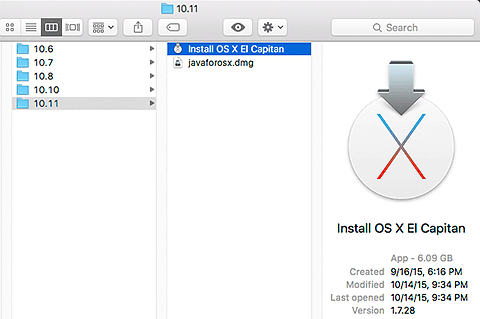Install Java For Mac El Capitan Jun 16, 2017 Many Mac users don’t need Java on their computer, but if you happen to have Java installed and want to remove it from a Mac then you can uninstall Java and JRE with a little effort. Step to step guide how to use 32bit version of Java in Eclipse 0 I can't run Eclipse on Macbook on Yosemite: 'Version 1.6.065 of the JVM is not suitable for this product.' How to fix this application requires the legacy Java SE 6 runtime which is unavailable for this version of the OS XIf anyone is using the beta version of El. CHIP – “The “El Capitan UX Pack” transforms Windows visually in the current Mac OS X 10:11.” DownloadTyphoon – “OS X Mavericks Transformation Pack will give you all new OS X Mavericks user experiences combined with iOS 7 graphics such as theme, wallpapers, system resources, and new OS X features combined altogether in single. If your Mac isn't compatible with the latest macOS, you might still be able to upgrade to an earlier macOS, such as macOS Catalina, Mojave, High Sierra, Sierra, or El Capitan. To get the latest features and maintain the security, stability, compatibility, and performance of your Mac, it's important to keep your software up to date.
Java is no longer installed with a OS X 10.11 El Capitan clean install, and you’ll find that after updating a Mac a prior version of JRE may no longer function.
You may come across when trying to use some particular applications or web content, “This application requires the legacy Java SE 6 runtime which is unavailable for this version of OS X.” error message, which means if you want to run that app you’re going to need to use an older version of Java.
If you do not need Java, you should not install Java. Java is, and always has been, the source of many security holes.
Here’s how you can install JRE (Java Runtime Environment).
Java For Mac El Capitan
Step 1. Open Safari and go to the Oracle Java downloads page and download the JRE .tar.gz version. You should end up with a file named something similar to jre-8u65-macosx-x64.tar.gz.
Step 2. Go to your Downloads folder and extract the JRE download or use Terminal to extract files:
Step 3. Open Terminal
Step 4. Edit the Info.plist file within to enable the JRE to be used from the the command line, and from bundled applications:
Step 5. Move the JRE folder to the correct location:
Java 6 For Mac El Capitan
Type password on prompt.

Be sure you are in the correct directory (the JRE folder) when you issue this command, because it will move your current directory to /Library/Java/JavaVirtualMachines/!
Step 6. Create a link to add backwards compatibility for some applications made for older Java versions:
You should be done now, so try and open the application. If it does not work, some applications require legacy Java 6 to be installed.
You can have it installed without actually using it, however, it’s possible to trick the applications into thinking legacy Java 6 is installed, without actually doing so.
Step 1.Disable SIP (System Integrity Protection) in OS X El Capitan. Here is tutorial to disable and enable SIP.
Step 2. Trick some applications into thinking that legacy Java 6 is installed by creating two folders with the following commands in Terminal:

Step 3. Don’t forget to enable SIP again after creating these directories.